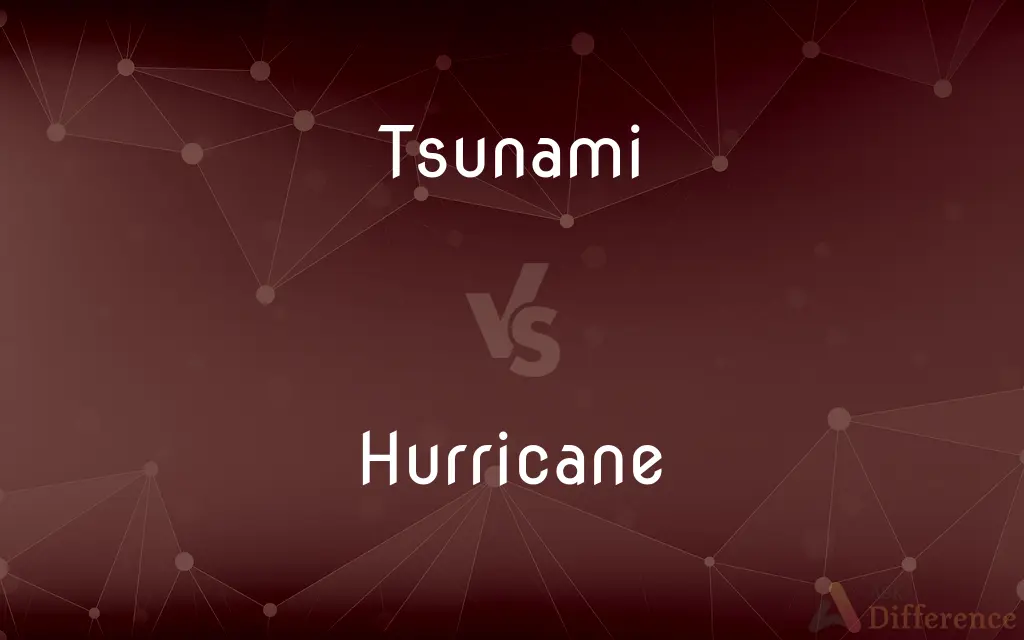Tsunami vs. Hurricane — What's the Difference?
By Fiza Rafique & Urooj Arif — Updated on April 17, 2024
A tsunami is a series of ocean waves caused by underwater disturbances, whereas a hurricane is a powerful tropical storm formed over warm ocean waters.

Difference Between Tsunami and Hurricane
Table of Contents
ADVERTISEMENT
Key Differences
A tsunami is generated by seismic activities such as earthquakes, volcanic eruptions, or underwater landslides, leading to large, fast-moving waves that can travel across oceans. In contrast, hurricanes develop from warm ocean waters, combining atmospheric disturbances and heat to form swirling storms with intense wind and rain.
Tsunamis are characterized by their incredibly rapid speeds in open water and their capability to increase in height dramatically as they approach shallow coastal areas. Hurricanes, on the other hand, are noted for their defined eye, extensive storm system, and slower movement over the ocean, potentially covering vast areas with severe weather conditions.
The impact area of a tsunami is typically along coastlines, affecting a narrower geographic region but with potentially devastating depth and speed of water flow. Conversely, hurricanes can affect large swathes of coastal and inland areas, bringing not only high winds but also heavy rainfall, leading to flooding and widespread destruction.
Warning systems for tsunamis involve seismic activity monitoring and ocean buoys that detect changes in water level. For hurricanes, meteorological satellites and radar are essential for tracking storm paths and intensity, providing more extended periods for evacuation and preparation.
Recovery from a tsunami involves dealing with immediate water damage and restoring infrastructure destroyed by forceful water movements. Hurricane recovery, while also involving water damage repairs, additionally requires rebuilding from wind destruction and addressing broader regional power and water service disruptions.
ADVERTISEMENT
Comparison Chart
Cause
Seismic activities (e.g., earthquakes)
Warm ocean waters and atmospheric conditions
Speed of Movement
Fast in open water; slows but grows on coast
Slower, swirling movement over ocean
Main Dangers
Rapid, high water flow; flooding
High winds, heavy rain, flooding
Impact Area
Coastal regions
Coastal and inland regions
Warning Systems
Seismic monitors, ocean buoys
Meteorological satellites, radar
Compare with Definitions
Tsunami
A series of ocean waves caused by large underwater disturbances.
A tsunami followed the earthquake.
Hurricane
A severe tropical cyclone with high winds and heavy rain.
The hurricane caused extensive damage.
Tsunami
Designated safe paths to higher ground.
Signs indicated the tsunami evacuation route.
Hurricane
Designed to withstand hurricane conditions.
The building was hurricane-proof.
Tsunami
Areas highly vulnerable to tsunami waves.
Coastal towns are often in the tsunami impact zone.
Hurricane
The time of year when hurricanes are most likely to occur.
Hurricane season peaks from June to November.
Tsunami
An alert issued if a tsunami is likely to strike.
The government issued a tsunami warning after the seismic activity.
Hurricane
A safe location for protection during a hurricane.
Locals gathered at the hurricane shelter.
Tsunami
A wave in a series that represents a tsunami.
The first tsunami wave hit the shore within minutes.
Hurricane
An alert that a hurricane may occur in the area.
Residents were on hurricane watch as the storm approached.
Tsunami
A tsunami ( (t)soo-NAH-mee, (t)suu-; from Japanese: 津波, lit. 'harbour wave', pronounced [tsɯnami]) is a series of waves in a water body caused by the displacement of a large volume of water, generally in an ocean or a large lake. Earthquakes, volcanic eruptions and other underwater explosions (including detonations, landslides, glacier calvings, meteorite impacts and other disturbances) above or below water all have the potential to generate a tsunami.
Hurricane
A severe tropical cyclone having winds greater than 64 knots (74 miles per hour; 119 kilometers per hour), originating in the equatorial regions of the Atlantic Ocean or Caribbean Sea or eastern regions of the Pacific Ocean, traveling north, northwest, or northeast from its point of origin, and usually involving heavy rains.
Tsunami
A long, high sea wave caused by an earthquake or other disturbance
The loss of human lives from this latest tsunami is staggering
Hurricane
A wind with a speed greater than 64 knots (74 miles per hour; 119 kilometers per hour per hour), according to the Beaufort scale.
Tsunami
A very large ocean wave caused by an underwater earthquake or volcanic eruption.
Hurricane
Something resembling a hurricane in force or speed.
Tsunami
A very large and destructive wave, generally caused by a tremendous disturbance in the ocean, such as an undersea earthquake or volcanic eruption. Tsunami are usually a series of waves, or wave train.
Hurricane
A severe tropical cyclone in the North Atlantic Ocean, Caribbean Sea, Gulf of Mexico, or in the eastern North Pacific off the west coast of Mexico, with winds of 119 km/h (74 miles per hour) or greater accompanied by rain, lightning, and thunder that sometimes moves into temperate latitudes.
Tsunami
(figurative) A large and generally unstoppable surge.
Hurricane
(meteorology) A wind scale for quite strong wind, stronger than a storm
Tsunami
A huge destructive wave (especially one caused by an earthquake)
Hurricane
"full—triple-full—full" – an acrobatic maneuver consisting of three flips and five twists, with one twist on the first flip, three twists on the second flip, one twist on the third flip
Hurricane
A violent storm, characterized by extreme fury and sudden changes of the wind, and generally accompanied by rain, thunder, and lightning; - especially prevalent in the East and West Indies. Also used figuratively.
Like the smoke in a hurricane whirl'd.
Each guilty thought to me isA dreadful hurricane.
Hurricane
A severe tropical cyclone usually with heavy rains and winds moving a 73-136 knots (12 on the Beaufort scale)
Common Curiosities
What primarily causes a tsunami?
A tsunami is primarily caused by significant underwater disturbances such as earthquakes or volcanic eruptions.
Which regions are most affected by tsunamis?
Coastal regions, especially around the Pacific Ocean's "Ring of Fire," are most susceptible to tsunamis.
How do hurricanes form?
Hurricanes form over warm ocean waters, fueled by the heat and moisture from the sea surface.
What are the speeds of tsunamis in open water?
Tsunamis can travel at speeds up to 500 miles per hour (800 km/h) in open water.
What are the economic impacts of hurricanes?
Hurricanes can cause extensive damage to infrastructure, agriculture, and tourism, leading to significant economic losses.
How long can a hurricane last?
A hurricane can last for over a week as it moves across the ocean and onto land.
What are the common warning signs of a hurricane approaching?
Common signs include changes in weather patterns, heavy rain, strong winds, and meteorological warnings.
What measures can people take to prepare for a hurricane?
Preparations include securing property, stocking up on emergency supplies, and knowing evacuation routes.
How do warning systems for tsunamis work?
They include seismic activity monitors to detect earthquakes and ocean buoys to measure sudden changes in water level.
How do tsunamis affect marine life?
Tsunamis can disrupt marine habitats and displace a large amount of sea life but typically do not have a long-term impact on marine populations.
How do communities rebuild after a tsunami?
Rebuilding involves clearing debris, restoring essential services, and improving coastal defenses.
Can tsunamis be predicted?
While immediate predictions are challenging, regions at risk can prepare based on seismic activity and historical data.
What role do governments play in hurricane preparedness?
Governments issue warnings, organize evacuations, and coordinate disaster relief and recovery efforts.
What is the difference in the scale used to measure tsunamis and hurricanes?
Tsunamis are not measured on a scale like hurricanes, which are categorized by the Saffir-Simpson scale based on wind speed.
How can architecture help in hurricane-prone areas?
Buildings designed to be hurricane-proof with features like reinforced walls and storm shutters can mitigate damage.
Share Your Discovery

Previous Comparison
Viscosity vs. Density
Next Comparison
Sultan vs. EmperorAuthor Spotlight
Written by
Fiza RafiqueFiza Rafique is a skilled content writer at AskDifference.com, where she meticulously refines and enhances written pieces. Drawing from her vast editorial expertise, Fiza ensures clarity, accuracy, and precision in every article. Passionate about language, she continually seeks to elevate the quality of content for readers worldwide.
Co-written by
Urooj ArifUrooj is a skilled content writer at Ask Difference, known for her exceptional ability to simplify complex topics into engaging and informative content. With a passion for research and a flair for clear, concise writing, she consistently delivers articles that resonate with our diverse audience.















































